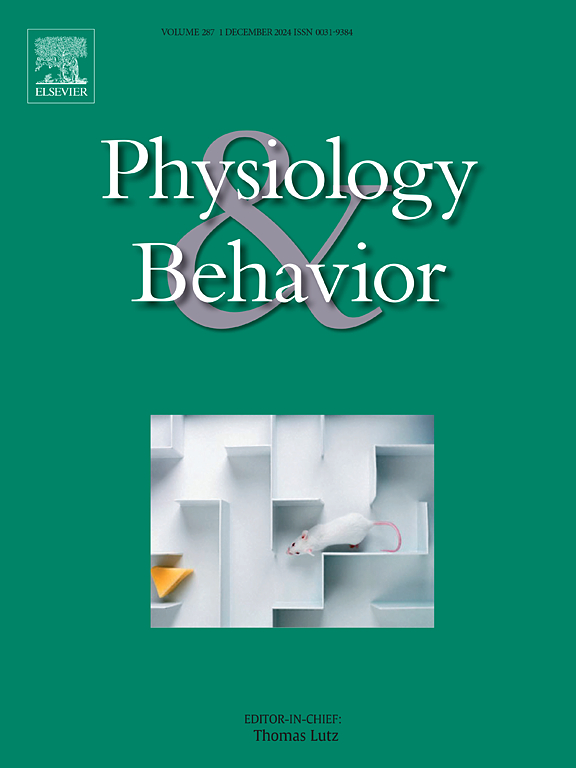BTBR和B6小鼠的产前应激和氟西汀暴露对成年雄性和雌性后代自闭症样行为的影响存在差异
IF 2.4
3区 医学
Q2 BEHAVIORAL SCIENCES
引用次数: 0
摘要
自闭症谱系障碍(ASD)在症状的多样性和严重程度上具有显著的异质性。产前压力和/或抗抑郁药物暴露可能是导致ASD异质性的主要因素。迄今为止,产前应激或选择性血清素再摄取抑制剂暴露的影响主要是在普通实验室大鼠和小鼠品系中进行的,而不是在自闭症的啮齿动物模型中进行的。本实验在BTBR自闭症小鼠模型中确定约束应激(G4 - G18期间每2天30分钟)和/或暴露于SSRI、氟西汀(G8 - G18期间3mg /kg)是否影响后代成年后的重复运动行为、焦虑和/或行为灵活性。与C57BL/6 J (B6)小鼠相比,雄性和雌性BTBR小鼠均表现出更高的梳理行为。产前操作不影响雄性BTBR小鼠的梳理,但组合增加了饲养和跳跃。产前应激、氟西汀和联合用药显著减少了雌性BTBR小鼠的自我梳理,同时增加了运动能力。这些产前操作也增加了雌性BTBR小鼠的饲养和跳跃行为。在B6小鼠中,产前应激条件增加了梳理行为。此外,暴露于产前应激和氟西汀的雄性BTBR小鼠以及产前暴露于氟西汀的雌性BTBR小鼠的反转学习能力受损。产前操作对两种小鼠的焦虑都没有影响。结果表明,产前暴露于压力和/或SSRI对自闭症样行为有长期影响,并可能导致自闭症的异质性和共发病。本文章由计算机程序翻译,如有差异,请以英文原文为准。
Prenatal stress and fluoxetine exposure in BTBR and B6 mice differentially affects autism-like behaviors in adult male and female offspring
Autism spectrum disorder (ASD) is characterized by significant heterogeneity in the variety and severity of symptoms. Prenatal stress and/or exposure to antidepressants may be major contributors to ASD heterogeneity. To date, the effects of prenatal stress or selective serotonin reuptake inhibitor exposure have been primarily examined in common laboratory rat and mouse strains as opposed to in rodent models of autism. The present experiments determined in the BTBR mouse model of autism whether restraint stress (30 min session every 2 days during G4 - G18) and/or exposure to the SSRI, fluoxetine (3 mg/kg during G8 - G18) affects repetitive motor behaviors, anxiety and/or behavioral flexibility in offspring at adulthood. Male and female BTBR mice exhibited elevated grooming behavior compared to that of C57BL/6 J (B6) mice. The prenatal manipulations did not affect grooming in male BTBR mice, but the combination increased rearing and jumping. Prenatal stress, fluoxetine and the combination significantly reduced self-grooming, while concomitantly increasing locomotion in female BTBR mice. These prenatal manipulations also increased rearing and jumping behavior in female BTBR mice. In B6 mice, the prenatal stress conditions increased grooming behavior. In addition, male BTBR mice exposed to prenatal stress and fluoxetine along with female BTBR mice prenatally exposed to fluoxetine were impaired on reversal learning. The prenatal manipulations had no effect on anxiety in either mouse strain. The pattern of results suggest that prenatal exposure to stress and/or a SSRI have long-term effects on autism-like behaviors and may contribute to the heterogeneity and co-morbidity observed in autism.
求助全文
通过发布文献求助,成功后即可免费获取论文全文。
去求助
来源期刊

Physiology & Behavior
医学-行为科学
CiteScore
5.70
自引率
3.40%
发文量
274
审稿时长
47 days
期刊介绍:
Physiology & Behavior is aimed at the causal physiological mechanisms of behavior and its modulation by environmental factors. The journal invites original reports in the broad area of behavioral and cognitive neuroscience, in which at least one variable is physiological and the primary emphasis and theoretical context are behavioral. The range of subjects includes behavioral neuroendocrinology, psychoneuroimmunology, learning and memory, ingestion, social behavior, and studies related to the mechanisms of psychopathology. Contemporary reviews and theoretical articles are welcomed and the Editors invite such proposals from interested authors.
 求助内容:
求助内容: 应助结果提醒方式:
应助结果提醒方式:


